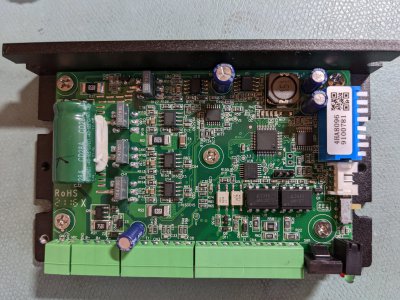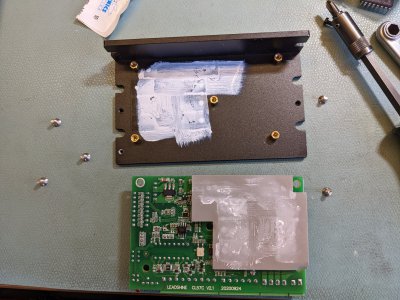- Joined
- Dec 18, 2019
- Messages
- 6,447
Opened the box. They painted over the part number for the processor, but that's pretty much normal. The power devices are on the bottom of the board and sandwiched against the heat sink plate. To take up the gap, they inserted an extra slice of insulator. The transistors are NOT physically attached to the heat sink with a fastener. Hey, that would be old school and cost a screw and a plastic insulator. So they saved 8 screws and 8 insulators. Otherwise, the board looks nice and dense. The dip switch is through hole. There's also a programming connector that was blocked by the cover. I presume that is how they flashed the processor. 4 pins. To get to the back side of the board, I have to disturb the driver transistors and the thermal paste, if there is any. I will loosen the 5 screws and see what happens... First need to put on an anti-static strap. You can see the anti-static mat. Well, it just lifts right off! Not much thermal compound there, but it does look like they used some kind of thermal compliant insulating mat.


You can see it is a Ledshine CL57C V2.1 board. Hey, it's right on the silkscreen. On the top left side of the board is the dipswitch and its associated resistors. They look like 0603's. They are 4.7K ohm. The signal side, I think, is on the right side. Going to be tough to shoehorn the isolator in on the bottom side. Only have 4.8mm between the board and the case. Plus I need to come up with a connector with 4 pins for the diodes and somehow mount it. Would be a tricky packaging job. But the circuit is easy. Short across the pins horizontally. Need an SMT opto, with a height under 3.6mm. I could dead bug it. A standard DIP package is a bit thick.


You can see it is a Ledshine CL57C V2.1 board. Hey, it's right on the silkscreen. On the top left side of the board is the dipswitch and its associated resistors. They look like 0603's. They are 4.7K ohm. The signal side, I think, is on the right side. Going to be tough to shoehorn the isolator in on the bottom side. Only have 4.8mm between the board and the case. Plus I need to come up with a connector with 4 pins for the diodes and somehow mount it. Would be a tricky packaging job. But the circuit is easy. Short across the pins horizontally. Need an SMT opto, with a height under 3.6mm. I could dead bug it. A standard DIP package is a bit thick.
Last edited:


